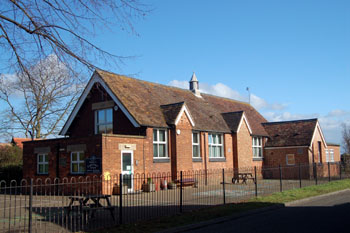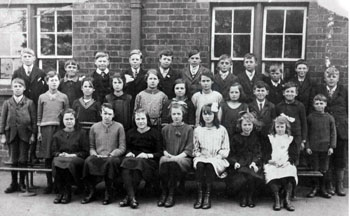
Cople Lower School February 2008
The first Education Act (more correctly known as the Elementary Education Act) was passed in 1870. It was a milestone in the provision of education in Britain, demonstrating central government's unequivocal support for education of all classes across the country. It also sought to secularise education by allowing the creation of School Boards. These were groups of representatives elected by the local ratepayers, and the Board had the powers to raise funds to form a local rate to support local education, build and run schools and pay the fees of the poorest children; make local school attendance compulsory between the ages of 5 and 13; and could even support local church schools, though in practice they replaced them, turning them into Board-run schools (known as Board Schools). Naturally, and luckily for local historians, the Act required a questionnaire of local schools in 1870.
The report for Cople stated that its Church of England School had accommodation for 135 children. (This is the school building provided by the 9th Duke of Bedford.)
School logbooks were from 1863 onwards required to be kept by every school receiving a government grant. CopleNationalSchool opened in its fresh premises on 1 February 1869, with Alice Pleasance as the Mistress. 84 pupils were on the registers on the first day, with attendance of 82 marked in the morning and 81 in the afternoon. The log book [SDCople1/1] records the changes of teaching staff in the first years of the school, and the difficulty in getting children to attend on a regular basis. As well as absence for illness (or alleged illness: when noting one girl as absent due to illness, the headmistress added with a touch of exasperation that she was ‘not so ill as to prevent her playing in the streets’), children were frequently kept home or stayed away to work, either at regular or seasonal tasks. The girls assisted with looking after younger siblings and also made lace. The boys helped out with agricultural tasks such as picking potatoes, driving cows or haymaking. On 4th November 1869, ‘14 boys stayed away all day to beat for the game.’ In January 1873 the then mistress Catherine Goddard noted, 'Took off Lucy Knights name who is now kept at home to make lace. Made a rule that the girls are not to stay at home more than two afternoons in a week to make lace.' Lucy was 9 years old at this time. Josiah Knight, a cousin of Lucy and also aged 9, was removed from the register in February, 'he having gone to work'. He was made to attend school again but in March 1874 the schoolmistress Esther Osborne noted in the logbook, 'Josiah Knight left the playground on the 3rd without leave and his mother would not allow him to return when sent for.' Children also met with accidents whilst working-- in 1880 Josiah's younger brother Frederick Knight was 'unable to attend school in consequence of having his foot crushed under the wheels of a [threshing] machine'.
Other reasons included the occasional, such as on 1st October 1869: ‘A ploughing match in the next village. Several children stayed away to go and see it.’
Louisa Spencer took over as Head Mistress in 1874 and remained until 14th February 1883 when she was replaced by Mary Laird. On the seventh anniversary of her appointment she took a group of teachers and children to Bedford:
'Monday October 3rd being the seventh anniversary of the Mistress's coming to Cople, she took the teachers and first class children [older children in the upper Standards] to Bedford for a trip on the river. School was opened at 1 and closed at 3 o'clock. The children walked to Bedford, stayed on the river until dark, had tea at the Coffee tavern, returned by the train, reaching Cople at 8.30 pm. The children behaved admirably.' For the week ending 31 March 1876, the headmistress records the receipt of a strong-box in which to keep records of the new School Board.
The first school boards in Bedfordshire were formed in 1871, and Cople’s was created in 1876, changing its status from a National School to a Board School. In 1878 the School Boards (comprising both nonconformist and Anglican members) were asked to supply details of how much religious instruction they had decided to provide. In Cople, ‘The Bible is read from 9.15 to 9.45, but without any doctrinal comments.’

Cople School senior group about 1900 [Z50/33/2]
A landmark Education Act was passed in 1902, coming into effect in 1903. It disbanded the School Boards and gave responsibility for the day-to-day running of education to newly formed Local Education Authorities, usually the county council, as in Bedfordshire. The old Board Schools thus became Council Schools-- Cople included-- whilst the old National, British and other non-Board schools became known as Public Elementary Schools.
Bedfordshire & Luton Archives & Records Service has a scrapbook of cuttings of visits made to most Bedfordshire schools by School Inspectors for a period from just before the First World War through the inter-war years [E/IN1/1]. The first report in the scrapbook dates from 1911, when average attendance was 59: Though there was some deficiency noted in some aspects of the pupils’ work, ‘In the senior division the work is good and in most respects the work is of a satisfactory character.… In the Infants' Division the Teacher manages to keep her three classes continuously and usefully employed, and the attainments of the children are, on the whole satisfactory.’ The next recorded visit was made two years later: ‘A most marked and general improvement has been effected during the time the present Head Teacher has been in charge of the school…. All the subjects are now carefully and well taught, and the condition of the school reflects much credit upon the Head Teacher who must have worked very hard to secure such very satisfactory results. In a disheartening year, in which epidemic sickness has largely prevailed, the Infants' Teacher has worked well and the results of her teaching are decidedly creditable.’
A brief report of the next visit, in 1921, reads: ‘This school is doing decidedly good work and the general level of attainment is quite satisfactory and promises well for the future. A considerable proportion of the work seen is above the average found in Schools of this type, and the tone is pleasant.’ The next report is dated 1925: ‘This School is going on quite satisfactorily. There is not much of the work of the young children now present in the School which calls for particular comment.’ The next report, of 1928 stated: ‘This is a very well conducted country school, in which a good standard of work is expected from the children. The results obtained are very creditable to the Head Mistress, who has this year had unusual difficulties owing to changes in staff.’
The next reported visit was in 1932, by which time it had been reorganised as a Junior School for children up to the age of 11 only; consequently its numbers had fallen, average attendance now being 32: ‘This School was visited in 1930 when it was still an all age school, but under a new Head who has now taken charge of it as a Junior Department. Then there was a falling off from the condition which it had previously reached; but the interval has seen a great change for the better again.’ The final report in the scrapbook dates from 1938: ‘There are now only 22 children (Juniors and Infants) on the books of this small country school. The Head Teacher has charge of 14 children, the Supplementary of 8. There are thus ample opportunities for attending to the special needs of individuals. The general condition of the school is not, at present, more than fair. During considerable periods between January and July this year five different types of epidemic disease have been prevalent and for eight weeks the attendance has been below 50 per cent.’ The final remarks are interesting: ‘The importance of teaching Nursery Rhymes in the Infant class and of national and folk songs in the Junior class was discussed.’
The third of the great Education Acts was that of 1944 which established the principle of County Primary Schools for children up to the age of 11, at which time they took an examination to determine the nature of the secondary school they would attend until they were 15, the most academically able going to grammar schools, the rest to secondary or secondary modern schools. The Act also created two types of successor to the public elementary schools - the Voluntary Aided and Voluntary Controlled schools. Voluntary Aided schools are those in which the Local Education Authority funds the school but the governing body is independent; they are usually Anglican or Roman Catholic schools. Voluntary Controlled schools own their own buildings, whilst the staff are employed directly by the governors.
In the 1970s Bedfordshire County Council introduced comprehensive education, doing away with the 11+ examination and grammar schools and introducing a tier of school between the old County Primary and County Secondary Schools. Thus, Lower Schools now taught children aged 4 to 9, Middle Schools from 9 to 13 and Upper Schools from 13 onwards. Cople School’s designation changed yet again from a County Primary to a Lower School, and continues to operate as such to the present day.